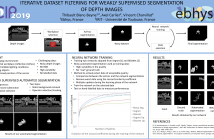
- Read more about AN ADAPTIVE FITTING APPROACH FOR THE VISUAL DETECTION AND COUNTING OF SMALL CIRCULAR OBJECT IN MANUFACTURING APPLICATIONS
- Log in to post comments
- Categories:
 9 Views
9 Views
- Read more about Virtual Reality Video Quality Assessment Based on 3D Convolutional Neural Networks
- Log in to post comments
As a new medium, Virtual Reality (VR) has attracted widespread attentions and research interests. More and more researchers have built their VR image/video database and devise related algorithms. However, the existing methods of VR video quality assessment are not very effective, and one of the most important reasons is that the database is not suitable. To this end, this paper proposes an efficient VR quality assessment method on self-built database.
- Categories:
 10 Views
10 Views
- Read more about TOWARDS REAL-TIME CRACK DETECTION USING A DEEP NEURAL NETWORK WITH A BAYESIAN FUSION ALGORITHM
- Log in to post comments
- Categories:
 17 Views
17 Views
- Read more about Estimating Physical Activity Intensity and Energy Expenditure using Computer Vision on Videos
- Log in to post comments
Estimating physical activity (PA) intensity and energy expenditure (EE) is a problem that typically requires the use of wearable sensors such as a heart rate monitor, or accelerometer. We investigate the accuracy of a computer vision system using videos recorded from a pair of wearable video glasses to estimate PA strength and EE automatically using age, gender, speed, and activity cues. Age and gender are obtained using the Deep EXpectation network, while activity is estimated from joint angles and movement speed.
ICIP2019.pptx
- Categories:
 9 Views
9 Views
- Read more about ManGAN: Assisting Colorization of Manga Characters Concept Art using Conditional GAN
- Log in to post comments
Colorization is a challenging task that has recently been tackled by deep learning. Line art colorization is particularly difficult because there is no grayscale value to indicate the color intensities as there is in black-and-white photograph images. When designing a character, concept artists often need to try different color schemes, however, colorization is a time-consuming task. In this article, we propose a semi-automatic framework for colorizing manga concept arts by letting concept artists try different color schemes and obtain colorized results in fashion time.
- Categories:
 130 Views
130 Views- Read more about Fast 6dof Pose Estimation with Synthetic Textureless Cad Model for Mobile Applications
- Log in to post comments
Performance of 6DoF pose estimation techniques from RGB/RGB-D images has improved significantly with sophisticated deep learning frameworks. These frameworks require large-scale training data based on real/synthetic RGB/RGB-D information. Difficulty of obtaining adequate training data has limited the scope of these frameworks for ubiquitous application areas. Also, fast pose estimation at inference time often requires high-end GPU(s) that restricts the scope for its application in mobile hardware.
- Categories:
 217 Views
217 Views
- Read more about Two-Dimensional Tomography from Noisy Projection Tilt Series Taken at Unknown View Angles with Non-Uniform Distribution
- Log in to post comments
We consider a problem that recovers a 2-D object and the underlying view angle distribution from its noisy projection tilt series taken at unknown view angles. Traditional approaches rely on the estimation of the view angles of the projections, which do not scale well with the sample size and are sensitive to noise. We introduce a new approach using the moment features to simultaneously recover the underlying object and the distribution of view angles.
- Categories:
 22 Views
22 Views
- Read more about ITERATIVE DATASET FILTERING FOR WEAKLY SUPERVISED SEGMENTATION OF DEPTH IMAGES
- Log in to post comments
In this paper, we propose an approach for segmentation of challenging depth images. We first use a semi-automatic segmentation algorithm that only takes a user-defined rectangular area as an input. The quality of the segmentation is very heterogeneous at this stage, and unsufficient to efficiently train a neural network. We thus introduce a learning process that takes this imperfect nature of data into account, by iteratively filtering the dataset to only keep the best segmented images. We show this method improves the neural network’s performance by a significant amount.
- Categories:
 49 Views
49 Views
- Read more about AUTOMATIC GENERATION OF PHOTOREALISTIC TRAINING DATA FOR DETECTION OF INDUSTRIAL COMPONENTS
- Log in to post comments
With the prosperous development of deep learning, people pay more attention to the needs of different training data. In
this paper, we propose a method to automatically generate realistic training data for industrial components detection. Our
- Categories:
 22 Views
22 Views
- Read more about LIP IMAGE SEGMENTATION IN MOBILE DEVICES BASED ON ALTERNATIVE KNOWLEDGE DISTILLATION
- Log in to post comments
Lip image segmentation, as the first step in many lip-related tasks (e.g. automatic lipreading), is of vital significance for the subsequent procedures. Nowadays, with the increasing computational power of the mobile devices, mobile applications become more and more popular. In this paper, a new approach is proposed, which is able to segment the lip region in natural scenes and is of acceptable computational complexity to be implemented in mobile devices. Two networks including a complex teacher network and a compact student network with the same structure are employed.
- Categories:
 19 Views
19 Views